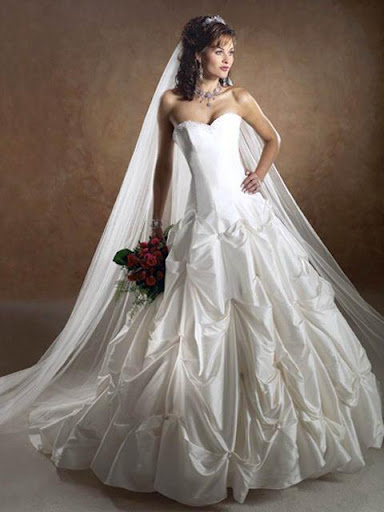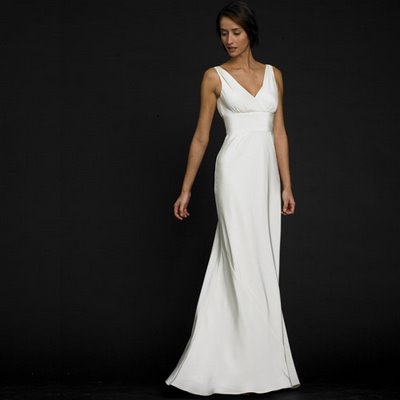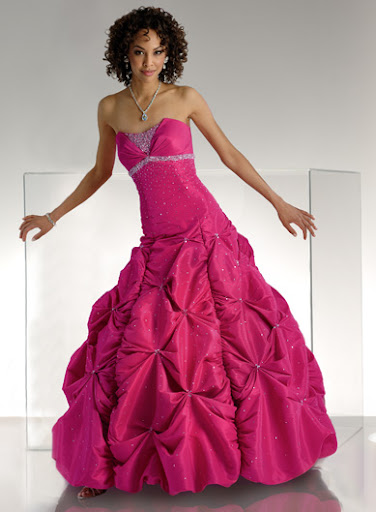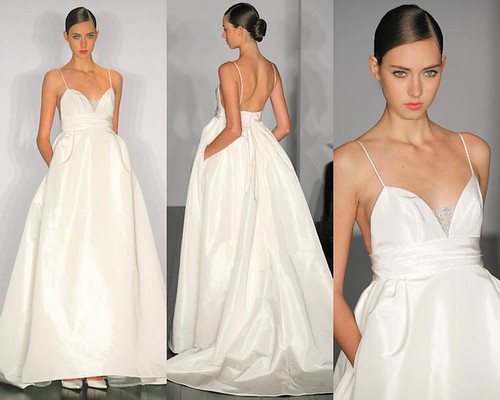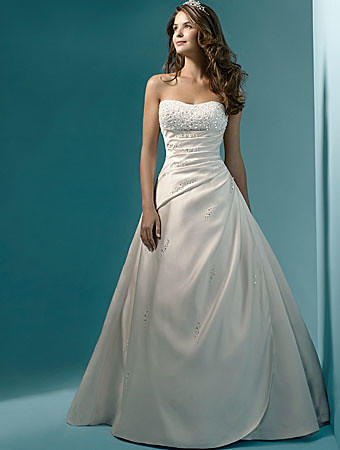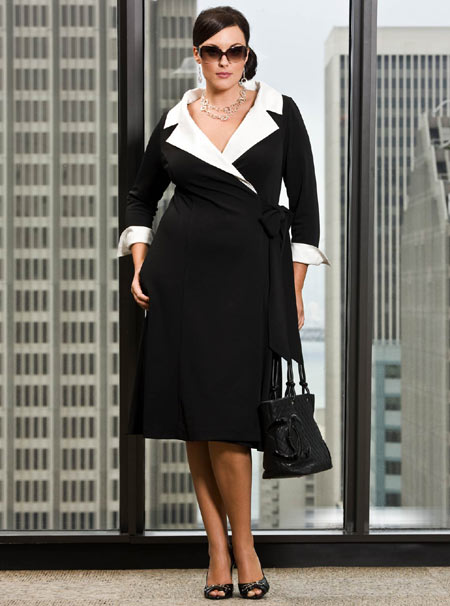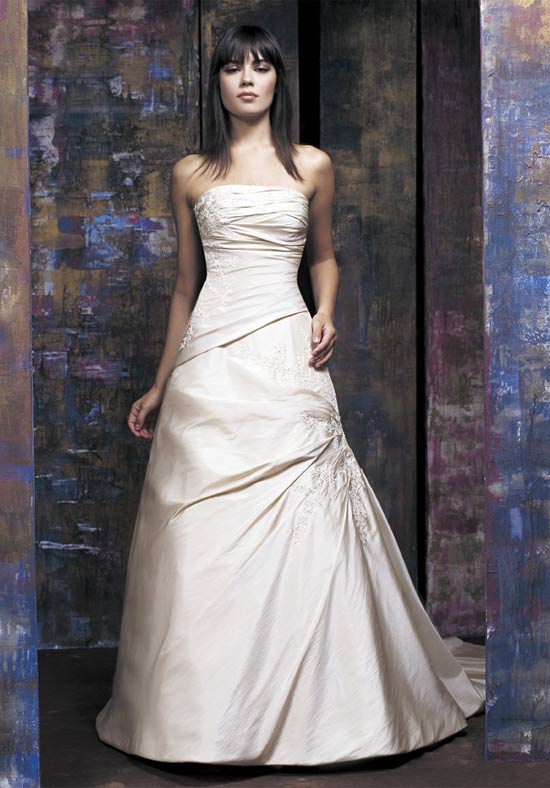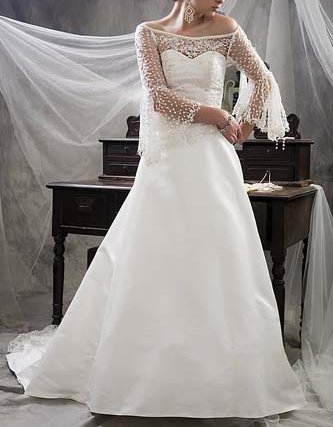
Wedding Dresses Design.3
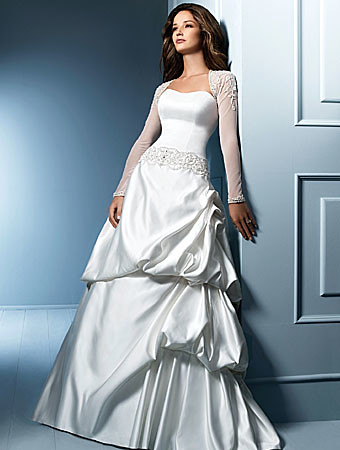
The Wedding Dress – How did it all begin?
Did you ever wonder how the tradition of wearing a wedding dress came about? Wedding dresses have been worn by brides young and old alike for centuries. In modern times almost anything passes for a wedding dress however, in times of old, traditional wedding dresses were flowing gowns usually white in color.
White is usually accepted as the "traditional" color of gowns, and many designer wedding gowns are still fashioned in this color, representing the "purity" and "innocence" of the bride to be. Many women opt for other colors, including blue, pink, cream, yellow and more.
Wedding dresses have changed with time much as everything in the world has. In times of old most women selected a gown based on her financial status. Women who were at an economic disadvantage usually did not have the luxury of selecting an extraordinary gown that would be worn only once. Rather, most selected something more "plain" that could be worn for church services and other occasions after their blessed day.
Wedding gowns of varying styles and colors were popular among the elite, and by and large represented the unique style and personality of the bride to be, as well as modern trends at the time.
Popular Colors
An old poem states about the color of a wedding dress that "Married in white, you will have chosen all right." This is not to say that all brides historically have chosen white for their wedding gown. In fact, many brides chose colors including blue, pearl and even black. Many brides believed that if they wore blue their husbands would remain true to them (also a famous line in the wedding poem). Pink was even a popular wedding gown color for a time, though its darker variant, red was often considered taboo because it was associated with "scarlet women".
Many women who did not have a large budget to spend on a wedding dress in times of old opted for fashions that could be worn any day, rather than solely on their wedding day. For their wedding day, they would dress up their gown with accessories and flowers, even bows that could be removed after the festivities.
Wedding Gown Fashion
In the United States for a short spell the color white fell out of favor, but around the time of the Industrial Revolution, when the department store made it possible for a bride with any budget to purchase the gown of her dreams, white once again became the fashion. The style worn by women has changed through time.
Wedding dresses fashioned during the Roaring twenties were very different from those that came about in the thirties. In the twenties, women sought out gowns that de-emphasized their shape, in line with the style of the flappers that was trendy at the time.
During the 30's most women emphasized their shape and wore gowns that highlighted their waists and bosoms. Perhaps the most interesting period of time for the wedding gown was during the 1980s, when big puffy sleeves and extravagant skirts were worn by a majority of women. These gowns, while well suited for trim and petite women, often were not the most flattering choice for the average size woman. Despite this, gowns did not trim down again until the mid to late 1990s.
Wedding Gown Fashion Today
As mentioned at the start, almost anything passes for a wedding dress today. More and more women are buying a wedding dress online, because of the wide variety and selection of unique and custom made gowns available.
Informal wedding dresses, designer wedding dresses and even discount wedding dresses can all be found online thanks to modern technology. More popular than even designer wedding dresses are discount bridal gowns online. Most brides to be can purchase extravagant looking, custom made gowns for a fraction of the cost they would find them in a department store.
Another benefit of buying a wedding dress online is convenience. With so many things to plan for a wedding (location, cake, reception, flowers, invitations, rehearsal dinner etc.etc) most women appreciate having a handy resource for buying their wedding dress. Most women also find a wider selection of sizes and custom features available when they shop online vs. when they shop in a traditional store.
Trends
Trends have changed when it comes to modern wedding attire. No longer do all brides seek out a traditional white gown for their special occasion. In fact, there is a huge selection of vintage and informal wedding dresses available, many of which don't even look like official wedding gowns.
Most dresses today focus on the unique personality of the bride rather than socially accepted "norms" when it comes to buying a wedding dress. In general many brides are looking for wedding gowns that are narrower than they have been in times of old, and those that offer clean silhouettes. These types of dresses usually lengthen the body and provide a slimming effect. Some more popular trends include the following:
* A-line dresses that are long and slimming
* Sheaths with trains built into the silhouette, so that it trails behind the bride
* Bias-cut wedding gowns that follow the natural curves of the body, ending in a small flare at the bottom
* Raised waistline ball-gown styles
* Square necklines that provide a fresh open look
* Off the shoulder dresses providing a full neckline
* Sleeveless or cap sleeve gowns which are especially popular for summer brides
* Empire waists which elongate the figure and shift the focus upward
Trends are also apparent with regard to fabrics. Satin and silk gowns have long been popular, though sheer fabrics are also becoming more trendy, including chiffon and organzas. Embroidery is also replacing lace for many modern gowns, and some brides are opting to accent their dresses with pearls and other quality beads.
No matter what style gown you choose, the most important thing is that you select one that makes you look good, feel good and happy on the most important day of your life. You're sure to find a superb selection when shopping online.
By Antigone Arthur
Favorite Wedding Dresses.2
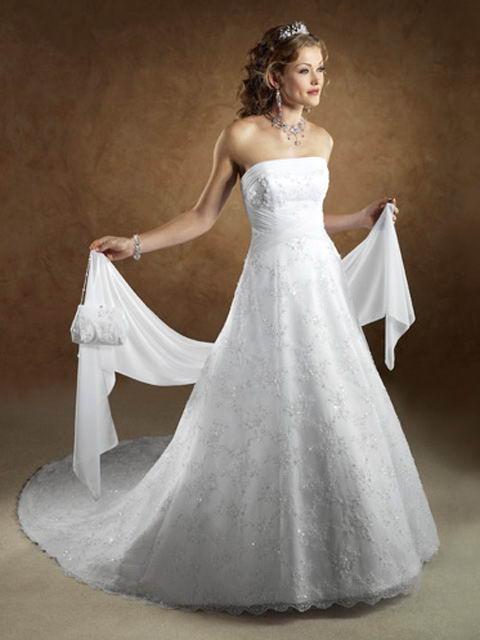
Wedding Dress Tips - What You Should Consider
Are you about to get married? For most women, this is the day that they've been planning for since they were young girls. If you feel the same, then it's understandable why you're out seeking advice, help and support to make your dream wedding a reality.

Let's face it. When it comes to wedding dress, most men just can't seem to understand the importance of picking the perfect wedding dress. True, you're only going to be wearing that gown once in your life, and your groom may still feel the inclination to tie the knot even if you showed up dressed in a potato sack, but you very well know that one of the most important days of your life merits an exceptionally special dress.
Top Tips to Choose the Perfect Wedding Dress
There are so many wedding details that you need to take care of, but it's equally important that you take the time to find the perfect wedding gown for you. To help you out, we've come up with a list of wedding dress tips for how you can look your best on your wedding day.

Tip 1: Is constantly going to your groom for tips getting you down? Find a female friend or relative who will gladly accompany you on your trips to the bridal shop.
Unless your groom is female fashion-savvy, he's not going to be much help when you ask him about the perfect wedding dress collar or neckline for you. Find a female companion or companions that you trust enough for second and third opinions.
Tip 2: Set a budget, and try to follow it.
Wedding dress budgets are hardly ever exact. You may need to spend more or you might end up spending less than you expected. The point is having a budget in mind can help you control the urge to splurge on your very special dress. Try your hardest to follow your dress budget, and pray that you find a great wedding dress bargain that will make your groom proud.
Tip 3: Consider the color of your gown.
You can stick with tradition and go for white, but if you want to add some color to your gown, then by all means, find the perfect color for you. Today, a number of modern brides are choosing colored wedding dresses instead of plain white ones. Stand out in the sea of white-clad brides by going for an eye-popping color.
You may want to take the season into consideration when picking out your wedding dress color, or you can simply go for what flatters your complexion best. Also be prepared for possible adverse reactions from your traditional guests. Console yourself with the thought that it's your wedding, and you can wear blue or even black if you want to.
Tip 4: Find the right wedding dress length.
Yes, wedding gowns can be short or long depending on the type of ceremony you're having and where you're planning on having it. There's a very basic rule when it comes to choosing the perfect wedding dress length, and it's to base your dress length on how formal the ceremony is.
If you're having a formal ceremony, then floor-length is the way to go. If it's an ultra-formal wedding, then you may want to add a cathedral train to your dress. For informal weddings, you can choose the hemline that flatters you best.
Short, or at least shorter wedding dresses are advised for casual and outdoor weddings for practical reasons. You don't want to get mud, twigs, leaves or sand on your floor-length designer wedding dress, right?
Tip 5: Pick the appropriate and the most flattering sleeve-length and style for your dress.
By appropriate, we're merely reminding you that a winter wedding may not be the best time to go for a halter, plunging and backless number unless you're planning on wearing over clothes.
If you're feeling conscious about your arms or your shoulders, then you might want to keep those problem areas covered. There are numerous sleeve styles and sleeve lengths to choose from; simply pick the one that fits the occasion best while making you feel pretty and comfortable in your dress.
Tip 6: Know the importance of finding the right skirt style and dress shape for your body.
Much like wedding dresses, brides come in different shapes and sizes. Take into consideration your physical assets, your overall body shape and your problem areas when making your choice of skirt style and dress shape.
For example, if you're shaped like an inverted triangle, with prominent shoulders and small hips, then a ball gown would balance your proportions creating the perfect silhouette and hourglass figure.
Tip 7: Determining the best neckline for you.
Your wedding gown's neckline can definitely affect your gown's overall appearance. You have numerous neckline options, but it's all a matter of finding the most suitable and flattering neckline for your frame.
Remember, in the same way that you need to take your assets, body shape and problem areas into consideration when picking out dress shapes and skirt styles, you also need to look at these factors when choosing your wedding dress neckline.
If you're planning on showing off your arms, your beautiful shoulders and pronounced collar bones, and you have an ample bosom to pull off the look, then the strapless gown is an excellent neckline choice. If you tend towards the flat side, then you can enhance your bust area with a bateau neckline.
Tip 8: Look for the right fabric.
A pure satin ball gown would not stand on its own without layers of tulle under it or hoops built into the dress. Your choice of fabric could directly affect your gown's overall look. If you tend to be uncomfortable or if you tend to feel itchy when you're wearing crisp and net-like fabrics, then go for the breezy and lightweight ones.
There are so many different fabrics to choose from. A way to familiarize yourself with these fabrics is to ask your wedding planner or the bridal boutique owner to help you distinguish between the different fabric types available.
Tip 9: Decide on whether or not you want or need a wedding train.
A wedding train means extra-fabric and detailing, which translates to paying more for your wedding dress. Unless your wedding is ultra-formal, you're not going to need a train.
If your heart is set on having a train that trails gracefully behind you, then pick your train length based on practicality. Your wedding train can decrease your mobility, making it difficult to maneuver between chairs and tables during the reception. A detachable wedding train is most advisable if you're planning on doing a lot of dancing and walking after the actual wedding ceremony.
Tip 10: Be Wary of wedding gown sizing and necessary alterations.
You'll find out more about this when you actually head to the bridal boutique to be measured.
You may already know your actual size, but don't be too surprised if they tell you that you're a size or two bigger than you thought.
This is not to say that they have faulty sizing charts; it only means that wedding dress boutiques and high street shops have a different way of determining your dress size. Your dress size is based on your body's largest dimension.
If you have prominent hips and a smaller bust area, then your wedding dress size will be based on your hip size.
Once you get your wedding gown, you need to check if alterations need to be made for a perfect fit. Most brides find that alterations are necessary to get the size right. Ask the boutique or shop owner for estimates on how much you're going to have to pay for dress alterations to determine if you're getting a great bargain or a rotten deal.
Tip 11: If you think your dress needs that extra sparkle and glam then go for some decorations and embellishments.
Wedding dress embellishments and decorations have one special purpose, and that's to bring something extra to your gown.
Additional decorations and embellishments are a great way of making your dress even more unique and fashionable.
A basic gown would look great with additional beading and perhaps some embroidery. If you want a more feminine gown, then adding a bow, some ribbons or three-dimensional flowers can give your dress the boost needed to make it an amazing and personalized wedding dress.
Find a great seamstress or wedding dress designer to help you pick out the right detailing for your gown.
Tip 12: Decide if you need over clothes for your wedding gown.
If you're having a winter wedding, and your heart is set on a strapless, A-Line, princess dress, then a great coat or bolero will help you keep warm during the wedding ceremony.Keep in mind that there are also some churches that require brides to wear modest attire for the ceremony. Rayon fringed shawls and floor-length feathered coats are excellent ways of keeping covered during the actual ceremony.On your way to your reception, simply slip out of these over clothes to show the full beauty of your wedding gown.Follow these helpful tips and keep these reminders in mind when dress-shopping, to make your hunt for the perfect wedding dress a more enjoyable and less stressful experience.
By Dennis Paguio
My Wedding Colections.3
How About Designing Your Own Wedding Dress?
As you probably have begun to realize, planning a wedding is both exciting and often more than a little nerve-wracking. Preparing for a ceremony as special as a wedding is plenty of cause for excitement and anticipation. However, there is so much to do and, most likely, since you'll want it to all go perfectly that's plenty of cause for anxiety and stressed nerves. And when you consider that it isn't the kind of thing we do on a regular basis, nor something that we normally have any training for, you need to ease up a little on the quest for perfection and try to focus on the excitement.

Your wedding dress is likely to be the most significant component of the wedding ceremony. Everyone's eyes will be on the bride. Whatever style of wedding you settle on, you'll find that there's a lot of traditions that relate to the wedding ceremony - even with some of the more unusual themed weddings. Still, there is room for you to add your own special touches - to make your wedding uniquely your own.

If you've never thought about actually designing your own wedding dress, you should give it some thought. If you've priced wedding dresses, you'll be aware that even low-end brands may cost over 5 or 6 hundred dollars. Dresses sold by bridal shops tend to include a lot of overhead and additional costs which you can avoid by designing your own wedding dress. If you have a friend or relative who is well-skilled in sewing, you can save even more money. One of the greatest benefits of designing your own wedding dress is that you will end up with a true one of a kind, a wedding dress no one else owns.

One caution - before you start designing be certain that you have or can find a person with the needed skills to actually create your wedding dress from your designs and ideas. This is not something you can wait until the last minute to do. You'll need to spend some significant time working with this person - well in advance of the wedding - so make sure of both the person's skills and availability.
A good place to start generating ideas for your wedding dress design is to consider the theme of the wedding and when and where it'll be held. Is it going to be a summer wedding? A winter wedding? Will it be outdoors or indoors? Will the reception be indoors or outdoors? What special characteristics does the location have? This is particularly important for an outdoor wedding since the answers can have a significant bearing on the style of wedding dress you design. As an example, an outdoor wedding in Texas in the month of August requires a wedding dress design that will not leave you soaked in perspiration. You should also consider how formal or informal the wedding ceremony itself will be.
If you don't already have some ideas for a design, a good place to start may be with bridal magazines, wedding dress catalogs and even on-line bridal shops. All these can be good sources for ideas to use in designing your own wedding dress.
While you are always free to design your wedding dress to reflect your personal style, most likely you'll want to follow one of the standard shapes generally used for wedding dresses:
A-line - Empire - Straight - Ball Gown - Mermaid - Strapless.
The shape of your body is an important factor in choosing a wedding dress shape that is most appropriate for you. If you have a full figure, or what is considered a "pear" shape, an A-line style dress may work best for you. A dress with this style accents the top-half of the body which is smaller while concealing a larger bottom half.
Not many women tend to opt for a straight wedding dress, including women with coke-bottle figures for whom this style of wedding dress was designed.
If neither of these styles seems to suit you, then a ball gown may be a good choice. This style of wedding dress has a snugger fit at the waist with a somewhat exaggerated full skirt.
A strapless style can be integrated with several shapes. The so-called mermaid style tends to be somewhat uncomfortable and not particularly popular. If you feel uncertain about what shape may work best for you, you can always visit a bridal shop and try on several styles to find the one that appeals most to you.
Once you have chosen the shape, design and style for your wedding dress, you are ready to consider the type of material. Silk and linen are both commonly used in creating wedding dresses. Both can be fairly costly and linen, in particular, tends to be quite delicate and require considerable care when putting the wedding dress together. There are also blended materials which use silk or linen along with other man-made materials allowing the creation of a fabric which is both beautiful and substantially easier to work with.
Once you've decided on the shape and design, and chosen the fabric, it's time to get together with the individual who will be making the wedding dress for and begin bringing the wedding dress of your dreams out of your dreams and into reality.
By Richard Keir
As you probably have begun to realize, planning a wedding is both exciting and often more than a little nerve-wracking. Preparing for a ceremony as special as a wedding is plenty of cause for excitement and anticipation. However, there is so much to do and, most likely, since you'll want it to all go perfectly that's plenty of cause for anxiety and stressed nerves. And when you consider that it isn't the kind of thing we do on a regular basis, nor something that we normally have any training for, you need to ease up a little on the quest for perfection and try to focus on the excitement.

Your wedding dress is likely to be the most significant component of the wedding ceremony. Everyone's eyes will be on the bride. Whatever style of wedding you settle on, you'll find that there's a lot of traditions that relate to the wedding ceremony - even with some of the more unusual themed weddings. Still, there is room for you to add your own special touches - to make your wedding uniquely your own.

If you've never thought about actually designing your own wedding dress, you should give it some thought. If you've priced wedding dresses, you'll be aware that even low-end brands may cost over 5 or 6 hundred dollars. Dresses sold by bridal shops tend to include a lot of overhead and additional costs which you can avoid by designing your own wedding dress. If you have a friend or relative who is well-skilled in sewing, you can save even more money. One of the greatest benefits of designing your own wedding dress is that you will end up with a true one of a kind, a wedding dress no one else owns.

One caution - before you start designing be certain that you have or can find a person with the needed skills to actually create your wedding dress from your designs and ideas. This is not something you can wait until the last minute to do. You'll need to spend some significant time working with this person - well in advance of the wedding - so make sure of both the person's skills and availability.
A good place to start generating ideas for your wedding dress design is to consider the theme of the wedding and when and where it'll be held. Is it going to be a summer wedding? A winter wedding? Will it be outdoors or indoors? Will the reception be indoors or outdoors? What special characteristics does the location have? This is particularly important for an outdoor wedding since the answers can have a significant bearing on the style of wedding dress you design. As an example, an outdoor wedding in Texas in the month of August requires a wedding dress design that will not leave you soaked in perspiration. You should also consider how formal or informal the wedding ceremony itself will be.
If you don't already have some ideas for a design, a good place to start may be with bridal magazines, wedding dress catalogs and even on-line bridal shops. All these can be good sources for ideas to use in designing your own wedding dress.
While you are always free to design your wedding dress to reflect your personal style, most likely you'll want to follow one of the standard shapes generally used for wedding dresses:
A-line - Empire - Straight - Ball Gown - Mermaid - Strapless.
The shape of your body is an important factor in choosing a wedding dress shape that is most appropriate for you. If you have a full figure, or what is considered a "pear" shape, an A-line style dress may work best for you. A dress with this style accents the top-half of the body which is smaller while concealing a larger bottom half.
Not many women tend to opt for a straight wedding dress, including women with coke-bottle figures for whom this style of wedding dress was designed.
If neither of these styles seems to suit you, then a ball gown may be a good choice. This style of wedding dress has a snugger fit at the waist with a somewhat exaggerated full skirt.
A strapless style can be integrated with several shapes. The so-called mermaid style tends to be somewhat uncomfortable and not particularly popular. If you feel uncertain about what shape may work best for you, you can always visit a bridal shop and try on several styles to find the one that appeals most to you.
Once you have chosen the shape, design and style for your wedding dress, you are ready to consider the type of material. Silk and linen are both commonly used in creating wedding dresses. Both can be fairly costly and linen, in particular, tends to be quite delicate and require considerable care when putting the wedding dress together. There are also blended materials which use silk or linen along with other man-made materials allowing the creation of a fabric which is both beautiful and substantially easier to work with.
Once you've decided on the shape and design, and chosen the fabric, it's time to get together with the individual who will be making the wedding dress for and begin bringing the wedding dress of your dreams out of your dreams and into reality.
By Richard Keir
Subscribe to:
Posts (Atom)



